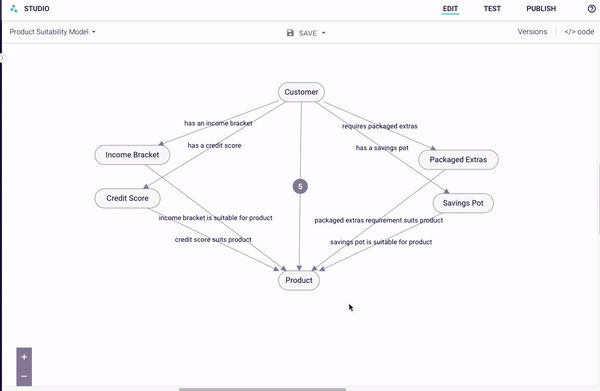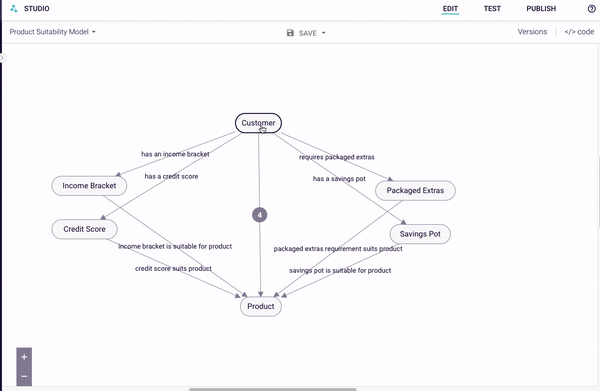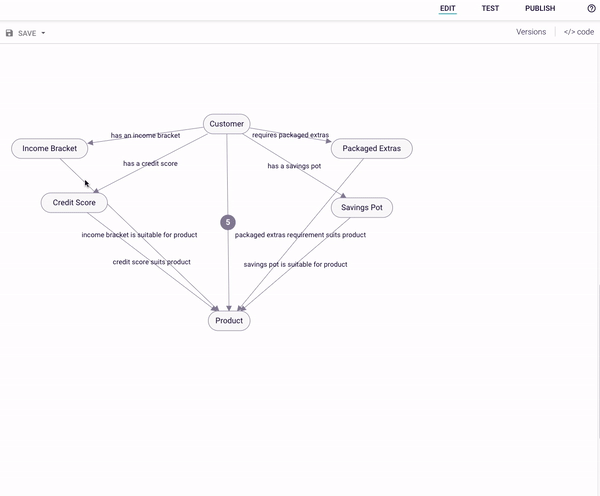Within the Rainbird Studio, knowledge authors can assign a level of certainty to facts and rules. End users can also express their certainty about particular facts. These certainty factors, along with the weighting of any conditions inside rules, have an impact on the certainty of the judgement that Rainbird returns.
By default, Rainbird will only use or consider a fact that has been inferred by a rule, if it is at least 20% certain about the inferred fact. However, authors can override this by specifying a minimum rule certainty on a rule.
Minimum rule certainty must be:
- a whole number
- greater than 0 and less than or equal to 100
- less than or equal to the rule’s certainty
You might want to increase or decrease the minimum rule certainty, depending on the knowledge map’s requirements.
A Decrease could be used if you want to broaden the number of facts Rainbird can consider.
An Increase could be used to narrow down the number of facts considered and to make the certainty of a rule stricter.
The model below gives a recommendation score for different bank account types based on the customer’s answers to questions in relation to four factors:
- Credit score
- Income bracket
- Packaged extras
- Savings pot
The answer options for each of the four factors uses a certainty factor to indicate how suitable it makes the customer for each product.
Some of the answer options have a low certainty factor (under 20) for certain product types:

Figure 1: Concepts instances with different Certainty
We would like all answers to be considered when we bring everything together in a rule; we will decrease the minimum rule certainty to achieve this.
In the example below, we have a plural relationship which goes from Customer to Product, ‘based on credit score’. The ‘based on credit score’ relationship has a rule with conditions to show that the customer has a credit score and that credit score indicates product suitability.
We know from the previous example that at least one of the credit scores has a certainty as low as 1% (in terms of suitability for a product), so if we want the rule to consider all credit scores, our minimum certainty should be changed to 1.

Figure 2: Creating a based on rule with minimum rule certainty 1
The example map uses a ‘based on’ rule for each of the four factors the overall decision takes into account and each of these uses a reduced minimum rule certainty.
We then have an overall rule (on a relationship between the ‘Customer’ and ‘Product’) which brings all of the ‘based on’ rules together to give a decision on which products most suit the customer.
The minimum certainty of the final rule will be increased to narrow the results that Rainbird returns down, as we want Rainbird to only suggest accounts for which the customer is at least 70% suitable. The minimum-rule-certainty on the rule has been changed from 20 to 70:

Figure 3: Narrow the outcome by increasing minimum certainty
Important: The certainty of any facts Rainbird infers are rounded to the nearest whole number, if applicable. Rainbird then verifies that the rounded certainty of the fact is greater than or equal to the minimum rule certainty value.
For example, if the minimum rule certainty of a particular rule is ’10’ and Rainbird infers a fact it is 9.4% certain about, the certainty of the fact will be rounded to 9% and will, therefore, be discarded. If the certainty of the inferred fact is 9.6 %, this would be rounded to 10% and the fact would become available for use in subsequent rules or conditions, or returned as the result of a query.
The RBLang below will generate the account recommendation map used in the example above. Click on ‘Export .rbird’ to download the knowledge map, or ‘copy RBLang’ and paste the code directly into Rainbird.
Query and Results
When viewing the knowledge map generated by the RBLang below, please run the query on the relationship ‘should be recommended product’ for an example of a query that takes minimum certainty into account.


